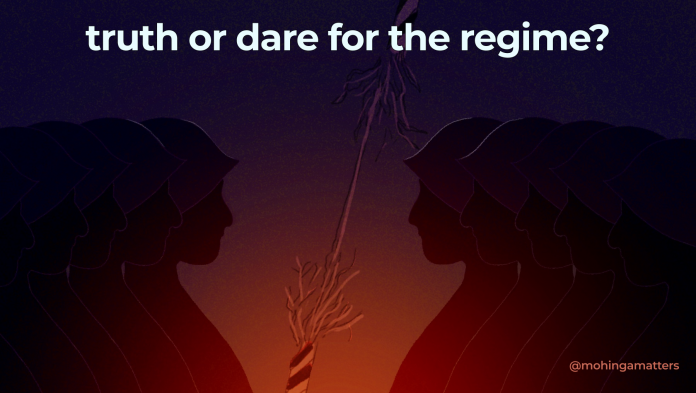Originally published on Mohinga Matters
Initial reports stated that at least 1,000 people had been displaced from their homes due to fighting between the Burma Army and the Kachin Independence Army (KIA) in Waingmaw Township in Myanmar’s northernmost Kachin State. Fighting began last month in Nam San Yang village, located 20-kms from the KIA headquarters of Laiza. Even though fighting between the two has been ongoing for several decades with a 17-year ceasefire from 1994-2011. This time the military regime is facing several frontlines nationwide. It decided to target one of Myanmar’s strongest Ethnic Resistance Organisations (EROs), the KIA, and risk losing control of other battlefields. Seng Mai Maran, the editor of Myitkyina News Journal, gives an update of what’s happening on the ground in Kachin State.
MM: We hear that the military regime has advanced its troops in Kachin State, especially in Nam San Yang village near Laiza, the KIA headquarters. How accurate is this news?
SMM: Yes, the regime has been increasing the number of troops around the KIA headquarters. This is the first time we are witnessing a potential military encounter in this location in the last few years. Since the coup, there was no significant action near Laiza as the regime had other priorities, such as dispersing demonstrations and clashing with PDF (People’s Defense Force). Now, the regime has turned its focus on the KIA headquarters.
MM: Why do you think the military is lurking around the KIA headquarters despite facing multiple fronts?
SMM: As we know, the KIA has been supporting armed resistance in many forms. The resistance forces in the upper Sagaing Region near the Kachin State have been strong and active, many of them are trained by and provided weapons by the KIA. So, this could be the regime’s strategy to keep the KIA occupied.
MM: Any possible influence from neighbouring China?
SMM: In the 2011-2018 war between the KIA and then-military, [it] managed to take control of areas near Laiza and held camps just a few feet from the KIA headquarters. The military was in such a strong position to take over Laiza altogether at that point. However, the generals did not attempt to do it. Because the China border is located very close to Laiza, it’s just a small bridge away, just like the Myanmar-Thailand border in Tachileik.
Any kind of military action could easily spill over the border. During the clashes in the past, a couple of heavy artillery shells from the military fell on the Chinese land and its government reportedly gave a stern warning to the Myanmar military. The Chinese government told the military officials that they did not want any explosions on their land, they did not even want to hear any explosive sounds. Thus, there is only one explanation: the regime’s forces have not attempted to attack Laiza just yet because they fear China. As such, the KIA headquarters has stood free for this long because it sits next to China.
MM: What is the displacement situation near the Nam San Yang village?
SMM: People in Nam San Yang village experienced war [from] 2011 to 2018. In 2011, when clashes restarted between the KIA and the military, people were forced to move to Myitkyina and live in church compounds. In 2018 under the government led by Aung San Suu Kyi, the military cleared the village area, making it habitable, and instructed IDPs (Internally Displaced Persons) to return to their homes, and many of them did so. The KIA at that time thought the battles could resume anytime because the village is a strategic location (located on the Laiza-Myitkyina highway road) so it did not make any instruction “go back or stay”.
The military stated that it did not want to see any IDPs in the town (Myitkyina), so they put people on their military trucks and sent them back to the village after they defused the landmines and explosives and reopened schools. So this is the second time for the civilians to run away from armed conflict. Just like the previous time, the Catholic churches have offered temporary space for the IDPs, as well as friends and families from less-conflicted (affected) areas. Education for children has been interrupted, of course.
MM: Can you predict any impact of this tension on the armed resistance in the rest of the country?
SMM: I think this tension will have an impact on the armed resistance in other regions of the country. Essentially, weapons used by the resistance forces in upper Myanmar are provided by the KIA; meaning if/when KIA faces a defence of its headquarters, there is a chance its support for the rest of the regions in this campaign could more or less slow down.
MM: What’s the situation facing the rest of the Kachin State? Any notable action from the Northern Alliance (KIA, Arakan Army, Ta’ang National Liberation Army & Myanmar National Democratic Alliance Army)?
SMM: The Northern Alliance, especially the AA, is observed conducting counter-offensives to the regime in Kachin State. In addition, the All Burma Students’ Democratic Front (ABSDF) is also active. The AA and ABSDF have been coordinating military activities since both groups originated in Laiza.
Mohinga Matters is a platform where aspiring writers share their thoughts, ideas and opinions freely.



